Nine Years After the South China Sea Arbitration Award: A Look Back at Its Lesson and the Path Forward
This week marks the ninth anniversary of the 2016 South China Sea arbitration ruling, a case initiated by the Philippines under UNCLOS. However, the case failed to resolve the underlying disputes. Instead, it exacerbated geopolitical tensions, deepened mistrust among regional states, and intensified militarization. China, along with several other nations, dismissed the ruling as legally flawed and politically motivated. Nearly a decade later, the arbitration’s lesson serves as a cautionary tale about the limits of legal mechanisms in resolving complex territorial and maritime disputes—especially when divorced from diplomatic engagement and regional consensus.
From the outset, China rejected the arbitration process, arguing that the Philippines had violated prior bilateral agreements to resolve disputes through negotiation. Beijing also insisted that territorial sovereignty issues—such as those involving Scarborough Shoal and the Spratly Islands—fall outside UNCLOS jurisdiction, since it has made an exclusionary declaration under Article 298 of the UNCLOS. While the tribunal ruled in favor of the Philippines on multiple counts, its decision lacked enforcement mechanisms. More critically, it failed to account for the broader geopolitical realities of the South China Sea, where historical claims, strategic interests, and economic imperatives intersect.

(Original comics by VSCS)
Several regional states, including Cambodia and Laos, expressed reservations about the ruling, fearing it would escalate tensions rather than foster cooperation. Even Vietnam and Malaysia, which have their own disputes with China, cautiously avoided endorsing the arbitration, preferring instead to pursue its claims through multilateral forums like ASEAN.
Rather than bringing clarity, the arbitration ruling accelerated destabilizing trends in the region. The Philippines, under President Rodrigo Duterte, initially downplayed the ruling in favor of warmer ties with Beijing, but recent administration has sought to reinforce the verdict’s legitimacy, including through strengthened defense cooperation with the United States.
Indeed, the US has cited the ruling to legitimize its increased military presence in the region, regularly conducting Freedom of Navigation Operations (FONOPs) near Chinese-controlled features. Other external actors, including Japan, Australia, and the UK, have similarly heightened their strategic involvement, positioning their actions as upholding a "rules-based order." However, many regional states view such external engagement as unnecessary interference, while China perceives it as deliberate containment—deepening mistrust and prompting escalatory responses.

(Japanese and U.S. vessels arrived in Manila for a scheduled trilateral coastguard drills on June 1, 2023. /CFP)
The result has been an alarming militarization of the South China Sea. Satellite imagery reveals a growing network of runways, radar installations, and missile systems across disputed features. Close encounters between naval and coast guard vessels have raised fears of accidental conflict. The arbitration, rather than discouraging unilateral actions, appears to have incentivized competing states to consolidate their positions through force rather than negotiation.
The arbitration case also exposed the shortcomings of a purely legalistic approach to resolving deeply political disputes. While international law can provide normative guidelines, it cannot substitute for direct dialogue and confidence-building measures. The Philippines’ decision to pursue arbitration without regional consensus alienated potential partners and made a negotiated settlement more difficult.
China’s refusal to participate in the proceedings further undermined the ruling’s legitimacy, reinforcing its preference for bilateral diplomacy. In the years since, China has sought to sideline the arbitration by advancing alternative frameworks, such as the Code of Conduct (COC) negotiations with ASEAN.
Nine years after the ruling, it is clear that lasting stability in the South China Sea will not come from legal victories or zero-sum competition. Instead, it requires a balanced approach that prioritizes:
1. Dialogue Over Confrontation – The arbitration demonstrated that adversarial legal proceedings often harden positions rather than bridge differences. A more effective strategy would involve revitalizing diplomatic channels, such as the China-ASEAN dialogue mechanisms, and exploring joint development agreements that shelve sovereignty disputes in favor of practical cooperation.
2. Economic Cooperation Over Zero-Sum Competition – The South China Sea is not just a strategic flashpoint but also a vital economic corridor. Rather than treating it as an arena for dominance, claimant states should explore cooperative ventures in fisheries management, hydrocarbon exploration, and marine environmental protection. The 2008 China-Vietnam agreement on joint fishing zones in the Gulf of Tonkin and China’s 2021 memorandum with Malaysia on oil and gas cooperation in disputed waters demonstrate the potential of such arrangements. These agreements prove that pragmatic collaboration—even amid unresolved sovereignty disputes—can reduce tensions while unlocking shared economic benefits.

(Ceremony for the Launch of the Fishery Resources Enhancement and Release Activity in the Beibu Gulf Between China and Vietnam in 2024. /Ministry of Agriculture and Rural Affairs)
3. Regional Consensus Over External Imposition – While external powers can play a stabilizing role, solutions imposed from outside the region often backfire. ASEAN centrality remains crucial, but the bloc must overcome internal divisions to present a unified stance. Together with China, all the other regional stakeholders should recognize that a rules-based order, when inclusive and equitable, can enhance the region’s long-term security and economic interests.

(US Secretary of State Marco Rubio attends the 32nd ASEAN Regional Forum during the 58th ASEAN Foreign Ministers' meeting at the Convention Centre in Kuala Lumpur, Malaysia, Friday, July 11, 2025. /CFP)
4. A Balanced Approach: Combining Diplomacy, Legal Norms, and Pragmatism – International law should inform—but not dictate—the resolution process. A pragmatic mix of diplomacy, confidence-building measures, and incremental agreements offers the best hope for reducing tensions.
The South China Sea arbitration ruling remains a divisive milestone. Nine years on, the lesson is clear: lasting solutions require regional dialogue and shared interests, not imposed rulings or power struggles. As Aisa-Pacific competition grows, the South China Sea tests whether states can prioritize cooperation over confrontation. Moving forward demands focusing on diplomacy, economic ties, and collective security—not relitigating the past.
(Author: Peter T.C. Chang, Special Invited Researcher of the CMG Expert Committee on South China Sea Studies, Former Deputy Director of Institute of China Studies, University of Malaya, Research Associate of Malaysia-China Friendship Association)














